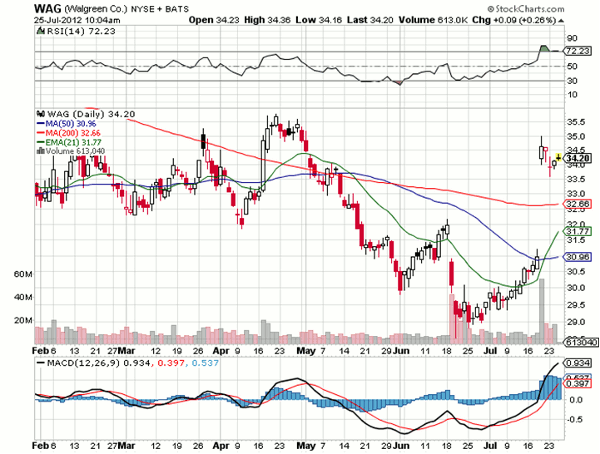Don Pendergast explains the story behind one stock's big recent move, and a relatively safe way to play its short-term trend.
News-driven price gaps are a wonder to behold at times, especially when a large-cap stock suddenly jumps by 11.79% in one trading session—and with most of the gain coming on the gap between Wednesday's close and Thursday's close.
Such is the case with shares of Walgreen (WAG), one of the largest retail pharmacy chains in the world. Once the details of its new long-term contract with Express Scripts (ESRX) were announced, investors and traders apparently decided that the deal was likely going to be paving the way for substantial gains in WAG's share price—and they voted with their "buy" buttons, and in a big way.
Technically, this news-driven gap was terrific for WAG's daily chart dynamics, as the stock is now back above its all-important 200-day exponential moving average (EMA), with its medium-term money flow also firmly in bullish territory as well. Normally, when a stock makes a massive, news-driven spike on super heavy volume, there is almost always some decent follow-through in the days and weeks (months) to come.
There can, however, also be some noticeable back-and-fill price action in the days following the breakout, causing latecomers to bail out of their positions early as post-gap profit takers seek to take their open profits and run—thus temporarily depressing prices before the next wave of buying begins. That hasn’t happened at the time of this writing, but could.
WAG's sudden gap higher now puts it back above its 200-day EMA, and onto the radar screens of savvy covered-call traders, too.
Next: How might a sharp trader seek to profit...
|pagebreak|Given that reality, how might a sharp trader seek to profit from the anticipated follow-through that appears likely in WAG, while still being able to stick it out through a possible short-term pullback (as in a test of gap support) in the meantime?
Well, one conservative trading solution is to construct an in-the-money (ITM) covered-call trade, one that could survive a deep post-gap pullback without causing a trader to be prematurely shaken out of his/her position. To do this using front-month options, we could simply buy 100 shares of WAG and then sell one August 2012 $31 call, creating a short-term ITM covered call.
As long as WAG stays above $31 by the close of trading on August 18, the shares will be called away, allowing the trader to keep the $365 in call premium collected at the time of sale. Since WAG is now trading at about $34.62, this is a trade setup that makes a lot of sense, because:
- Bullish follow-through is very likely in WAG between now and August option expiration, meaning there is a high probability that the shares will be called away at August option expiration.
- A pullback below $31 is also unlikely, but even if that happened, the fast time decay of an option with only four weeks of time value remaining would mean that any losses incurred on this setup would be relatively minor, particularly if such a deep pullback occurred during the last ten to 14 days of the call's life.
Open interest in the August $31 calls is 6,188 contracts, and the bid-ask spread is also decent in WAG's calls and puts, so this could be a very good covered-call trade to check out in the next session or two.
Using a 21-day EMA (in green on the chart above) is a simple and easy way to trail a stop-loss on any covered-call trade and to eliminate any emotion from the process of closing out a trade that just isn't performing right. Try the 21-day EMA trail on your next covered-call trade, and you'll likely be very impressed with the way it works.
Don Pendergast can be found at Linear Trading Systems.






















